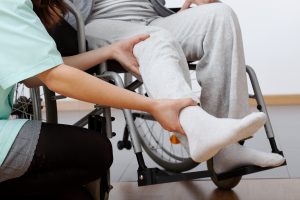– APRIL 2022 –
 Taking a holistic approach to Central Cord Syndrome (CCS)
Taking a holistic approach to Central Cord Syndrome (CCS)
Central Cord Syndrome (CCS) can impact people at any age. In young people, it usually occurs after a high energy injury obtained in an accident, such as a fall horse riding or cycling. As we age, it’s more common to gradually lose our sense of balance, resulting in more frequent accidents falling from a standing position.
At Active Edge Physiotherapy, we specialise in the best ways to treat CCS. This is a rare area of expertise for physiotherapists to be trained in so we’d like to shed light on how important it is to view the body holistically. Every system within the body is interconnected; when one area is not functioning fully, it can impact many other systems that would not typically be considered in a CCS physio treatment programme.
Here’s a few examples to illustrate how holistic thinking is crucial to effectively support CCS:
Skin conditions
If someone has suffered CCS, the injury to the middle part of the spinal cord usually affects the arms more than the legs and can cause quadriplegia. When a person is confined to a wheelchair, not having the full use of their arms is going to impact their ability to eat and drink, wash themselves, brush their hair or drive a powered wheelchair. Logically, this then becomes a key area of focus for physio exercises. However, what isn’t so obvious is for someone who has lost feeling at the top of their legs, they can’t feel when their circulation is getting cut off during long periods of sitting down. Pressure injuries can result from not moving enough, leading to wounds on the skin but this is not information that someone will necessarily volunteer if they’re not directly asked about their skin by their physio.
Bladder and bowel dysfunction
An additional implication of losing feeling at the top of the legs is that medical intervention might be required to open the bowels or to be able to urinate. For some, a catheter could be required to ease this situation. Again, without a physio asking about bowel and bladder control, this is sensitive information people can feel embarrassed about sharing and won’t necessarily bring it up themselves.
Wheelchair skills
In hospital, a person will be taught how to drive their electric wheelchair. While effective within this controlled environment, where physiotherapy staff are on hand should any challenges arise, it can be a different story at home. Often a wheelchair will need to be reprogrammed to meet the needs of the home environment. A common hazard is if a chair is accelerating too fast whilst crossing a road, the footplates can hit the ground and flip the chair user out onto the floor. We run thorough checks to ensure the risk of dangers like this are minimised.
Respiratory compromise
All of the muscles that engage to be able to breathe properly are linked to the neck. For someone with CCS, weakness in their arms can impact their respiratory system. If they are a smoker, have asthma, or a lung disease prior to their injury, their ability to breathe will be further compromised. Contrary to what you might expect, sitting up doesn’t help people with quadriplegia breathe more easily; lying down is the best option.
It is these finer details, among many others, that can make a significant difference to progress following a spinal cord injury. These are the kind of things that get missed by a physio who is not specialised in spinal cord rehabilitation.
If you need to refer people in your care who require spinal cord injury physio, we are your first port of call to provide specialised support.For their physiotherapy needs, please book a free 15-minute consultation with our team here at Active Edge Physio. Alternatively, complete the referral form online and we’ll be in touch within 24 hours (on week days) to explore the best way forward.